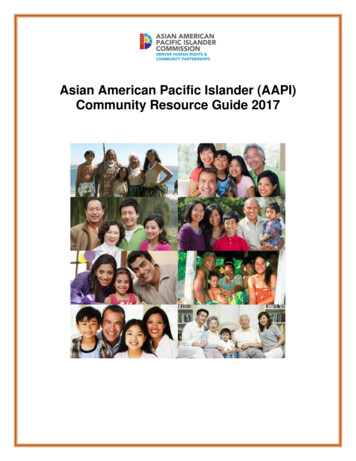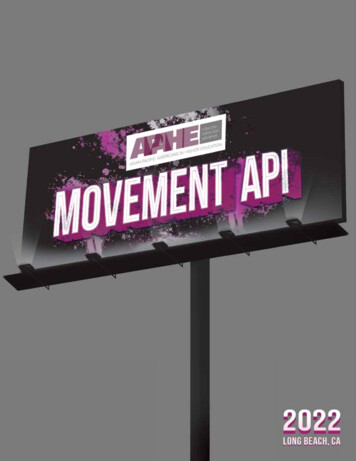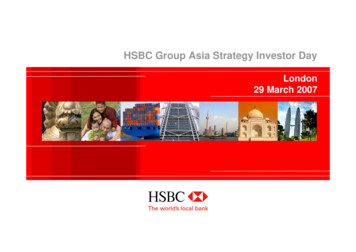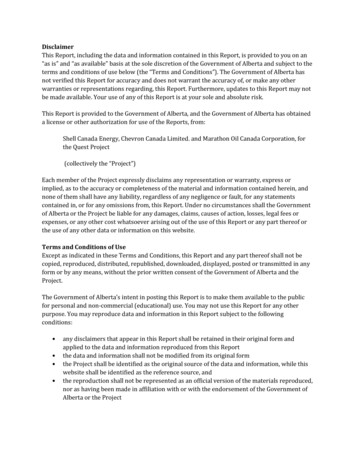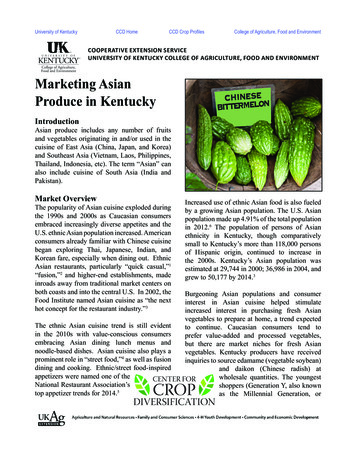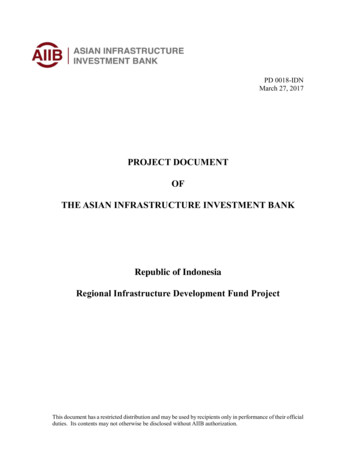
Transcription
PD 0018-IDNMarch 27, 2017PROJECT DOCUMENTOFTHE ASIAN INFRASTRUCTURE INVESTMENT BANKRepublic of IndonesiaRegional Infrastructure Development Fund ProjectThis document has a restricted distribution and may be used by recipients only in performance of their officialduties. Its contents may not otherwise be disclosed without AIIB authorization.
CURRENCY EQUIVALENTS(Exchange Rate Effective 27 March, 2017)Currency Unit Indonesian Rupiah (IDR)US 1 IDR 13,333FISCAL YEARJanuary 1 – December 31ABBREVIATIONS AND IRREMPESIAESMFESMSAsian Development BankAsian Infrastructure Investment BankAnalisis Mengenai Dampak Lingkungan (Environmental Impact Analysis)Anggaran Pendapatan dan Belanja Daerah (Local Government Budget)Badan Perencanaan Pembangunan Nasional (National DevelopmentPlanning Ministry)Bank Indonesia (Indonesia’s Central Bank)Badan Layanan Umum (General Service Agency)Badan Layanan Umum Daerah (Local-level General Service Agency)Badan Nasional Penanggulangan Bencana (National Disaster ManagementAuthority)Bank Pembangunan Daerah (Regional Development Banks)Badan Pemeriksa Keuangan (Indonesia’s Supreme Audit Institution)Badan Pusat Statistik (Central Statistics Agency)Badan Usaha Milik Daerah (Local Government-Owned Enterprise)Badan Usaha Milik Negara (National Government-Owned Enterprise)Compound Annual Growth RateCountry Partnership FrameworkDesignated AccountDana Alokasi Khusus (Specific Purpose Grant)Dana Alokasi Umum (General Purpose Grant)Dana Bagi Hasil (Revenue Sharing Grant)German Investment and Development CorporationDaftar Isian Pelaksanaan Anggaran (government budget utilizationdocument)Directorate GeneralDewan Perwakilan Rakyat Daerah (Local-level Legislature)Debt Service Coverage RatioEnvironmental AssessmentEconomic Internal Rate of ReturnEnvironmental Management PlanEnvironmental and Social Impact AssessmentEnvironmental and Social Management FrameworkEnvironmental and Social Management System
vironmental and Social Safeguards and Business ContinuityManagementFinancial Intermediary / IntermediationFinancial ManagementFinancial Management AssessmentGross Domestic ProductGovernment of IndonesiaGrievance Redress ServiceInternational Bank for Reconstruction and DevelopmentInternational Competitive BiddingInternational Development AssociationIndonesian RupiahIndonesia Sustainable Urbanization MDTFInternational Finance CooperationInterim Financial ReportIndonesia Infrastructure Finance FacilityIndonesia Infrastructure Guarantee FundIndigenous Peoples Planning FrameworkLand Acquisition and Resettlement Action PlanLand Acquisition and Resettlement Policy FrameworkLocal GovernmentLocal Government and Decentralization ProjectLembaga Kebijakan Pengadaan Barang/Jasa Pemerintah (Indonesia’sNational Procurement Policy Agency)Lembaga Pembiayaan Pembangunan Indonesia (Indonesian DevelopmentFinancing Agency)Municipal Development FundMulti-donor Trust FundManagement Information SystemMinistry of FinanceMinistry of Home AffairsMinistry of Public Works and HousingMid-term ReviewNon-bank Financial InstitutionNational Competitive BiddingNet Interest MarginNon-performing LoanNet Present ValueOtoritas Jasa Keuangan (Financial Services Authority)Operations ManualProgrammatic Advisory Services and AnalyticsPerusahaan Daerah Air Minum (Local-level Public Water Utility)Project Development FacilityProcess FrameworkPusat Investasi Pemerintah (Government Investment Center)Peraturan Pemerintah (Government of Indonesia Regulation)Public-Private Partnership
DSECOSLASMBCSNGSOESPSESUNTAUKLUPLUS USDRPWBWDPPeraturan Menteri Keuangan (Regulation Issued by the Minister ofFinance)Project Management UnitPT. Sarana Multi Infrastruktur (A State-Owned Enterprise under Ministryof Finance for Infrastructure Financing)Regional Development AccountRekening Dana Investasi (Investment Fund Account)Recipient-executed Trust FundRegional Infrastructure Development FundReturn on EquityReturn on InvestmentRencana Pembangunan Jangka Menengah Daerah (District-level Mediumterm Development Plan)Rencana Pembangunan Jangka Menengah Nasional (National Mediumterm Development Plan)Sertifikat Bank Indonesia (Indonesia Central Bank Certificate)Strategic Business UnitSystematic Country DiagnosticSwiss Secretariat for Economic AffairsSubsidiary Loan AgreementSumitomo Mitsubishi Bank CorporationSubnational GovernmentState-owned EnterpriseSistem Pengadaan Secara Elektronik (e-Procurement System)Surat Utang Negara (Indonesian Government Bond)Technical AssistanceUpaya Pengelolaan Lingkungan Hidup (Environmental ManagementMeasures)Upaya Pemantauan Lingkungan Hidup (Environmental MonitoringMeasures)United States DollarUrban Sector Development Reform ProjectWorld BankWajar Dengan Pengecualian (Qualified Audit Opinion)
Table of Contents1.PagePROJECT SUMMARY SHEET . 12.STRATEGIC CONTEXT . 33.4.A.Country context . 3B.Sectoral and Institutional Context . 4THE PROJECT . 5A.Rationale. 6B.Objective . 6C.Project Description and Components . 6D.Cost and financing . 10E.Implementation arrangement. 10PROJECT ASSESSMENT . 14A.Technical . 14B.Economic and Financial . 15C.Fiduciary and Governance . 16D.Environmental and Social . 17E.Risks and Mitigation Measures . 19ANNEXESAnnex 1: Results Framework and Monitoring. 21Annex 2: Detailed Project Description . 24Annex 3: Economic and Financial Analysis . 34Annex 4: Sovereign Credit Fact Sheet . 41Annex 5: Coordination with World Bank . 43
1. PROJECT SUMMARY SHEETRepublic of IndonesiaRegional Infrastructure Development Fund ProjectProject No.ClientBorrower(s)Implementation AgencySector(s)Subsector(s)ProjectObjectives / Brief ProjectDescriptionProject ImplementationPeriod (Start Date and End Date)Expected Loan Closing DateProject cost andFinancing PlanAIIB Loan(Size and Terms)Co-financing(If any) (Co-financier(s), Size andTerms)Environmentaland Social CategoryProject Risk (Low/Medium/High)Conditions for Effectiveness andDisbursement(If any)000012Republic of IndonesiaPT. Sarana Multi InfrastrukturUrban infrastructureThe project objective is to increase access toinfrastructure finance at the subnational levelthrough a sustainable financial intermediary.The project has 2 components, which includeComponent 1: Capital Support for RIDF andComponent 2: Project Development Facility.Component 1 will cover the capital costs of theinfrastructures, while Component 2 will helpbuild a subproject pipeline for RIDF tification,planning,andpreparation.Start Date: April 15, 2017End Date: December 31, 2020June 30, 2021Project Total Cost: US 406 millionAIIB: US 100 millionWorld Bank: US 100 millionGOI: US 203 millionSECO: US 3 millionUS 100 million with a final maturity of 10 years,including a grace period grace period of 5 yearsat the Bank’s standard interest rate for sovereignbacked loansWorld Bank - US 100 million, sovereign-backedloan with a final maturity of 10 years, including agrace period of 5 years.FIMedium(i) effectivenessofSubsidiaryLoanAgreement between the Borrower andPT.SMI (Financial Intermediary).1
Key CovenantsPolicy AssurancePresidentVice-President, CIODirector General, InvestmentOperationsManager, Investment OperationsProject Team LeaderProject Team Members(ii) effectiveness of the World Bank loandocuments;(iii) adoption of regulations establishingprocedures to intercept fiscal transfers tosubnational governments.The Borrower shall establish satisfactoryprocedures for the management of theContingency Fund at the Ministry of Finance.The VP Policy and Strategy confirms an overallassurance that the Bank is in compliance with thepolicies applicable to the ProjectJin LiqunD. J. PandianSupee TeravaninthornKe FangSylvester Hsu, Senior Investment OperationsSpecialistBaihui Sun, Project Assistant;Frederick Esmundo, Environmental Specialist;Ghufran Shafi, Senior Investment OperationsSpecialist;Haiyan Wang, Senior Finance Specialist;Ian Nightingale, Procurement Specialist;Philip Daltrop, Senior Legal Consultant;Philip Sayeg, Infrastructure Consultant;Somnath Basu, Senior Social Specialist2
2.STRATEGIC CONTEXTA. Country Context1.Indonesia, located in Southeast Asia, is the world’s largest archipelagic country.With a population of over 250 million, and a GDP per capita of US 3,524 (2014), Indonesiahas emerged over the last decade as a vibrant middle-income economy. Poverty inIndonesia was more than halved from 24 percent in 1999 to 11 percent in 2014, whenviewed against the national poverty line1. However, despite the substantial reduction in thepoverty rate, there are large and growing inter-regional disparities within Indonesia.Indonesia’s Gini coefficient index2 rose from 0.33 in 2005 to 0.40 in 2016.2.Continued rural-urban migration and population concentration in cities have drivenup the country’s urbanization rate from 46 percent in 2005 to 54 percent in 2015. There aremore than 27 cities with a population greater than 0.5 million, representing a total of 53.2million or 39% of the country’s urban population in 2015.3 The island of Java, where thecapital city Jakarta is located, accounts for about 57 percent of the country’s population of259 million estimated in 2016. Along with continued urbanization is an economic shiftfrom an agriculture-based economy to an urban service-based and manufacturing economy.Of the 20 million jobs created between 2001 and 2011, 18 million were in urban areas,marking a substantial change in the spatial distribution of the country’s employments.3.Indonesia, and its cities in particular, face a backlog of significant infrastructureneeds across all sectors and threatens to stifle future growth and prosperity. Inadequateinfrastructure is consistently identified by firms as a constraint on their operations andinvestment in Indonesia.4 Levels of access to, and the quality of, basic services – such asclean water, sanitation, drainage, housing and transportation – are low and in many casesworsening. In 2015, only about 69 percent of Indonesia’s population had access to cleandrinking water, and just 30 percent of households in urban areas had access to piped water– a decline of four percentage points since 2002. Piped sewerage networks are present inonly 12 cities, which in total serve only two percent of the urban population. The NationalDisaster Management Authority (BNPB) lists 22 cities at ‘extremely high risk’ of urbanflooding. The Ministry of Public Works and Housing (MPWH) estimates that over 38,000hectares of urban and peri-urban land are classified as slums. Urban road networks areunable to cope with the rapid growth in traffic, with an estimated 57 percent of local roadsclassified as being in bad condition.4.Infrastructure investment played a key role in driving growth and poverty reductionin the 30 years prior to the 1997 Asian financial crisis. Infrastructure investment averaged1World Bank 2015. Country Partnership Framework for the Republic of Indonesia. Report No. 99172.November.2The Gini index measures the gap between the rich and the poor, with 0 representing perfect equality and 1representing perfect inequality.3https://en.wikipedia.org/wiki/List of Indonesian cities by population, accessed February 24, 2017.4World Bank, Indonesia Economic Quarterly – Current challenges, future potential, June 2011, pp.283
7 percent of GDP from 1995-97, and after falling during the 1997 crisis it has struggled torecover. Total infrastructure investment was around 3-4 percent from over 2011-2013.55.A fall in spending on the part of government, state-owned enterprises (SOEs) andthe private sector caused the decline in infrastructure investment as a proportion of GDP.Private sector investment declined from 2.3 percent of GDP during 1995-1997 to 0.4percent from 2008-2011. Infrastructure investment by SOEs and the central governmentfell by 1.8 and 1.9 percentage points, respectively, while subnational government spendingincreased by 0.9 percentage points. Subnational governments are now leading ininfrastructure spending in Indonesia, accounting for 39 percent of total infrastructurespending in 2010-2011, and for more than half of national public investment in 2015. Butthis is barely sufficient to keep up with the depreciation of local public assets, let alonemeeting the demand for new infrastructure.B. Sectoral and Institutional Context6.Currently available financing instruments in Indonesia are limited and ill-fitting forthe nature and scale of the required subnational-level infrastructure investment. In recentyears, Indonesia has developed PPP vehicles for commercially viable infrastructure (e.g.energy generation, distribution and transmission; toll roads; airports and ports), but themarket for PPPs is oriented towards large-scale revenue-generating projects. Regulationshave been amended recently to enable subnational governments to issue bonds for urbaninfrastructure, but municipal bonds remain untapped, and only the larger cities or provinceswith high fiscal capacity would be in a position to issue such bonds in the absence of amature municipal bond market.6 On the revenue side, subnational governments have verylimited revenue-raising capacity, collecting about 11 percent of total government revenuein 2015 and receiving majority of their funding from central government transfersSubnational government budgets (APBD) can only be used to pay for small-scale projectsor marginal improvements in basic services that take less than one year to complete, due togovernment budgetary rules.7.A key gap is therefore the so-called ‘missing middle’ that spans the range of urbaninfrastructure including water, waste management, drainage, roads and other essentialcommunity facilities that requires significant investment due to the infrastructure backlog.By its nature, urban infrastructure is expensive, taking several years to implement, andhaving a long economic life with benefits accruing over many years. Revenues from userfees, even where applicable, accrue slowly and steadily, and usually require government’ssupport in getting investment off the ground. At present, no financial institution inIndonesia provides access to long-term financing for subnational public infrastructureWorld Bank, Indonesia Economic Quarterly – Current challenges, future potential, June 2011, pp.28MoF recently issued Ministerial Regulation PMK 180/2015 (revising the earlier PMK 111/2012) on theprocedures for issuing municipal bonds, including the administrative assessment process.564
investment. Addressing this gap is a critical priority for the Government of India (GoI) (seeFigure 1).Figure 1: The ‘Missing Middle’ of Infrastructure Finance in Indonesia8.Since the 1970s, the GoI has implemented a number of initiatives to facilitatefinancing for subnational infrastructure investment, with limited success. These initiativesinclude the establishment of: (i) Rekening Dana Investasi (RDI) which is an InvestmentFund Account; (ii) Regional Development Account (RDA); (iii) Subsidiary LoanAgreement (SLA); and (iv) Pusat Investasi Pemerintah (PIP) or Government InvestmentCenter. The RDI, RDA and SLA instruments have experienced significant arrears withlimited drawdowns on available finance, while the more recent PIP lending, which isrelatively small in scale and scope, has been comparatively more successful.9.After a number of years efforts made by the government and supported by IFIs, asound subnational debt framework is now in place in Indonesia7. The World Bank estimatesthat local governments at the 30 largest cities would be able to borrow up to US 3.8 billionunder such framework. In parallel to expanding access to finance, addressing theeffectiveness and efficiency of local government spending across all sectors is also critical.Subnational governments in Indonesia also lack the technical, institutional or financialcapacity to carry out strategic infrastructure investments and keep pace with rapidlyexpanding demand for local services.3. THE PROJECT7GoI has regulations in place that impose conservative restrictions to regulate subnational borrowingconsistent with international standards.5
A. Rationale10.The Regional Infrastructure Development Fund Project (the Project) aligns withGoI’s development priorities as defined in the National Medium Term Development Plan(RPJMN). The 2015-2019 RPJMN clearly states the massive need for infrastructuredelivery through all modes, including subnational spending. More specifically, RPJMN alsomentions the use of mechanisms such as a municipal development fund (MDF) for urbaninfrastructure. The design of the proposed project operation has taken account of thoselessons learnt as described below (refer paragraph 24).11.The Project is well aligned with the Bank’s primary mandate, i.e. to promoteeconomic development in Asia through investment in infrastructure and other productivesectors. The Project supports the national government’s decentralization program that aimsto strengthen the role and autonomy of subnational governments and enhance thesubnational debt framework. The Project would support the subnational governments’investment in, and capacity to manage, critical infrastructure that will benefit the urbanpopulation through the enhancement of employment, commercial opportunities,connectivity, and goods and services delivery.12.The Project complements the Indonesia Infrastructure Finance Facility (IIFF) andIndonesia Infrastructure Guarantee Fund (IIGF), both of which aim to support GoI inleveraging private finance into commercially-viable infrastructure projects.B. Objective13.The project objective is to increase access to infrastructure finance at the subnationallevel through creation of a sustainable financial intermediary, a Regional InfrastructureDevelopment Fund (RIDF), that channels funds from the AIIB, the World Bank, and thegovernment to the subnational governments. The main project beneficiaries are residents inurban areas that will be served by the infrastructure subprojects funded under the project.14.Achievement of the objective will be measured through two sets of resultsindicators: (i) increased access to infrastructure finance at the subnational level; and (ii) thefinancial performance and health of RIDF. Agreed results indicators are set out in the resultsframework contained in Annex 1.C. Project Description and Components15.The Project aims to support the structuring and operationalization of the RIDF as afinancial intermediary which lends directly to subnational governments. Located within PTSarana Multi Infrastruktur (Persero) (PT. SMI 8 ), the RIDF will increase subnational“PT SMI” is an infrastructure financing company which was established on 26 February 2009, as a StateOwned Enterprises (SOE) with 100% shares owned by the Government of Indonesia through the Minister ofFinance Republic of Indonesia. PT SMI plays active role in facilitating infrastructure financing as well aspreparing project and serving advisory for infrastructure projects in Indonesia. PT SMI carries the duty of86
governments’ access to finance for basic infrastructure. GoI has indicated its preference fora two-tranche approach for the RIDF, to enable refinement of RIDF’s business model afterthe initial years of operation. Under Tranche 1, the Bank will provide financing of US 100million in partnership with the World Bank (WB), who will also finance US 100 million.Together, they will cover half of the initial capital of RIDF. Subsequently, it is anticipatedthat additional financing will be sought for Tranche 2, so that the aggregated total borrowingfrom the Bank and WB for RIDF will reach US 500 million. GoI’s request for Tranche 2can be initiated sooner if the funding for Tranche 1 is utilized earlier than planned.16.Through the Project, it is expected that subnational governments will be able toaddress their critical infrastructure needs more effectively and overcome annual fundingconstraints with the dedicated funding available through the RIDF. The proposed RIDF is adomestic financing solution for urban infrastructure, and is a core element of a nationalplatform for sustainable urbanization, which includes a series of vertical national sectorinvestment and technical assistance programs for, but not limited to: (i) urban transport; (ii)urban water supply and sanitation; (iii) drainage, flood and hazard risk; (iv) solid wastemanagement; and (v) slum upgrading and affordable housing, as illustrated in Figure 2.Figure 2: RIDF and a National Platform on Sustainable Urbanization17. The Project is structured with two components as described below.Component 1: Capital Support for RIDF.18.This component will provide up to US 400 million for PT. SMI to operate RIDF asa financial intermediary, which will extend loans directly, at its own credit risk, tocreditworthy subnational governments for economically viable infrastructure projects. It isanticipated that RIDF’s initial focus will be on district-level (kota and kabupaten)supporting the Government’s infrastructure development agenda for Indonesia through partnerships withprivate investors and multilateral financial institutions.7
governments, before eventually scaling up to more complex regional and inter-regionalprojects at the provincial level, as its appraisal and financial capacity deepens. As itsbusiness grows, the RIDF can also lend directly to local-level state-owned enterprises (e.g.PDAMs (Local level public utility), and Perusahaan Daerah (PD) or Regional levelgovernment enterprises).19.Eligibility of Subprojects. The RIDF will fund subprojects9 that fall within theclear jurisdictional responsibility of the subnational governments under Indonesia’sdecentralized system. The subprojects must be economically viable and have cleardevelopment and poverty reduction impacts. The eligible sectors include water supply,sanitation, sewerage, drainage, solid waste, urban transport including roads, low-incomehousing, and slum upgrading.Eligibility criteria are set out in Table 1 below.20.12345678Table 1: Eligibility Criteria for RIDF’s Financing,per GoI RegulationsInfrastructure to be financed is public infrastructure that is most needed (priority) andis contained in the RPJMD.Approval of the relevant legislature (DPRD) at the subnational-level.Subnational government is not in arrears, whether with SLA or other loan sources.DSCR of at least 2.5Loan amount should not exceed 75% of the accumulated general revenue amount inthe APBD of the previous fiscal year.Current fiscal year APBD deficit, if any, is within the limits prescribed by applicableregulations.Audit results from BPK (supreme audit institution) from each of the last three yearsshould be at least WDP (qualified opinion) or better.A recommendation (“pertimbangan”) from the Ministry of Home Affairs based on astructural review of the subnational government’s annual budget (APBD).21.The subprojects under Tranche 1 are expected to be implemented over four years,from April 2017 to December 2020. Further details are provided below under Section 4Aon technical aspects.Component 2: RIDF Project Development Facility22.A Project Development Facility (PDF) will be established as part of the Project.With the objective of building a pipeline of subproject investments for the RIDF, the PDFwill support subnational governments in subproject identification, planning, andpreparation. PDF support will help ensure that subprojects are consistent with the technical,financial, economic, social and environmental appraisal standards of RIDF. It will also helpto lower the costs of project preparation for subnational governments, provide expert9Individual infrastructure investments funded by the overall RIDF project.8
assistance in standardizing designs, and produce a pipeline of quality subprojects for theRIDF.23.(i)(ii)(iii)(iv)(v)(vi)The activities eligible for PDF support are:project identification and preliminary structuring;project preparation studies, including feasibility studies, detailed engineeringdesigns, and safeguards instruments;design and supervision assistance;advisory services related to financial management, environmental and socialassessments, etc.;preparation of procurement and contract documents; andtraining for subnational governments on the above.Lessons Learned and Reflected in the Project Design24.The design for the Project has benefited from lessons learned from Indonesia’sdomestic experience with the financing of infrastructure through subnational governments,as well as from international experience with financial intermediary (FI) lending forsubnational infrastructure. Below are the key lessons that have been taken into account inthe formulation of the Project. More details on these lessons are given in Annex 2.25.Key lessons from domestic experience include the following:(i)The direct implementation of subnational infrastructure financing instruments orvehicles by MoF is likely to achieve limited success due to a number of inherentgovernmental constraints(ii)Supply-driven lending results in poor performance and weak ownership at thesubnational level(iii)Subnational infrastructure financing needs to take full account of the range ofpossible risks26.The practice of FI lending for subnational infrastructure has a long and mixed trackrecord in developing countries. As part of Project preparation, a wide range of experienceswere examined, including those in Colombia (FINDETER), India (TNUDF), Morocco(FEC), the Philippines (LOGOFIND), South Africa (INCA), and Vietnam (HIFU).(i)Autonomous and ‘arms-length’ governance structures are highly correlated with FIfinancial sustainability and strong performance.(ii)On aggregate, FIs do not have a strong track record on achieving significant sectoror institutional reforms, or capacity building objectives.27.In developing the proposed design for the RIDF, a few alternatives were consideredand rejected. One such option was to set up the RIDF as a wholesale facility that will lendthrough commercial banks to the subnational governments. The wholesale model has theadvantage of credit risks being shifted away from the FI to the participating commercial9
banks. However, the credit provided under the Project could partially replace commercialfinancing thus would not greatly expanding available financing. Further, if the wholesalecredit is subsidized, commercial banks not participating in the scheme will be placed at acommercial disadvantage.28.A pure credit enhancement model was also considered, where the project fund isused to guarantee all or part of the commercial lending risks, and thus the Project wouldhave offered the potential of drawing in private capital instead of setting up the RIDF.However, a number of factors suggest that this would not be the most effective way forward.Firstly, it is unlikely that a credit enhancement entity alone would be enough to encouragebanks and other financial institutions to give long-tenor loans to subnational governments,given the maturity mismatch that would arise from the short-term nature of most bankdeposits in Indonesia. Secondly, there is limited international experience with pureguarantee facilities which have leveraged on private finance. Moreover, GoI has alreadytransferred PIP lending assets to PT. SMI, giving PT. SMI the clear mandate to function asa lender to subnational governments, and ultimately to raise resources from the domesticcapital market for such lending.D. Cost and Financing29.The total project cost is estimated to be US 406 million. The financing plan for theProject is outlined below.Table 2: Project Cost and Financing(US million)Project ComponentsCostGoI1. Capital Support for RIDF4002002. RIDF Project Development Facility6*3Total406203WB1003*103AIIB100100(*) Includes US 3million in grant from Swiss Secretariat for Economic Affairs (SECO) channeled via WB30.The initial size of US 400 million for the RIDF is sourced from a comb
the private sector caused the decline in infrastructure investment as a proportion of GDP. Private sector investment declined from 2.3 percent of GDP during 1995-1997 to 0.4 percent from 2008-2011. Infrastructure investment by SOEs and the central government fell by 1.8 and 1.9 percentage points, respectively, while subnational government spending



